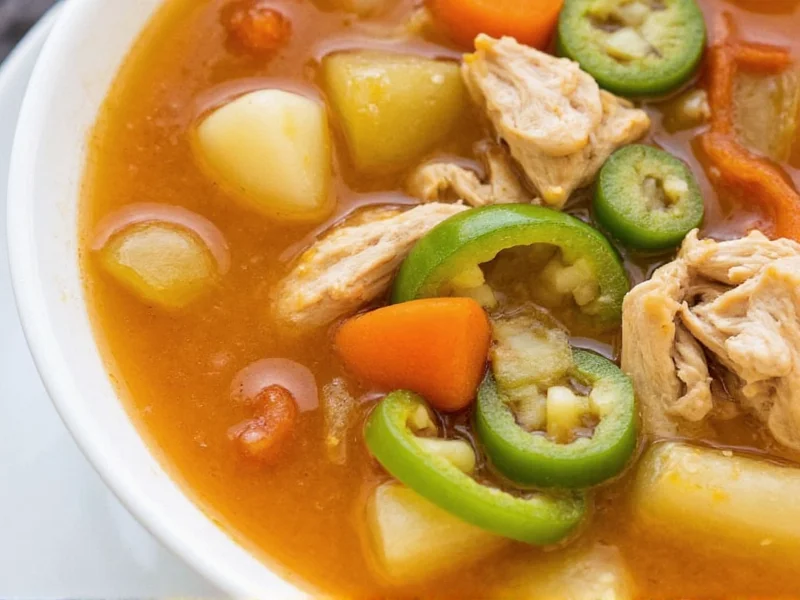The Nutritional Powerhouse in Your Bowl
Chicken and vegetable soup isn't just comforting—it's scientifically backed nutrition. Research published in the Journal of Food Science confirms that properly prepared chicken soup contains carnosine, an amino acid that supports immune cell function during upper respiratory infections. The vegetable components provide a rainbow of phytonutrients:
| Key Vegetable | Nutritional Contribution | Optimal Cooking Time |
|---|---|---|
| Carrots | Vitamin A (beta-carotene) for immune support | 20-25 minutes |
| Celery | Potassium and antioxidants for inflammation reduction | 15-20 minutes |
| Leeks | Prebiotic fibers for gut health | 10-15 minutes |
| Spinach | Vitamins K, A, and folate (add at end) | 2-3 minutes |
Building Blocks of Perfect Chicken Vegetable Soup
The foundation of exceptional homemade chicken vegetable soup starts with quality ingredients. For maximum flavor extraction and nutritional benefit, use bone-in chicken pieces rather than pre-cooked shredded chicken. The bones release collagen and marrow during simmering, creating natural gelatin that gives the soup body and provides joint-supporting compounds.
When selecting vegetables for your chicken vegetable soup from scratch, prioritize seasonal produce for peak nutrient density. Winter months call for hardy vegetables like parsnips and turnips, while summer allows for fresh zucchini and green beans. Always add delicate greens like kale or spinach during the final minutes of cooking to preserve their vitamin content.
Step-by-Step Preparation Guide
Creating restaurant-quality chicken vegetable soup at home requires attention to timing and technique:
- Build your flavor base: Sauté onions, garlic, and celery in olive oil until translucent (5-7 minutes)
- Add protein element: Brown 1.5 lbs bone-in chicken thighs in batches to develop fond
- Create the broth: Cover with 8 cups cold water, add 2 tbsp apple cider vinegar (helps extract minerals from bones), and simmer covered for 45 minutes
- Strain and return: Remove chicken, strain broth, return clear broth to pot
- Add vegetables: Start with hard vegetables (carrots, potatoes), simmer 15 minutes
- Finish with delicate ingredients: Add soft vegetables and shredded chicken, cook 5-7 minutes
- Season at the end: Adjust salt and pepper after all ingredients are cooked
Customizing Your Chicken Vegetable Soup
Adapt this versatile recipe to suit dietary needs and flavor preferences:
- For immune support: Add 1-inch fresh ginger and 2 cloves garlic during final 10 minutes
- For gut health: Include 1 cup chopped leeks and 2 tbsp miso paste (stirred in off-heat)
- For weight management: Increase non-starchy vegetables to 6 cups total, reduce chicken to 1 lb
- For meal prep: Prepare base broth without potatoes (which become mushy), add fresh when reheating
Troubleshooting Common Issues
Even experienced cooks encounter challenges with chicken vegetable soup. Here's how to address frequent problems:
Cloudy broth: Always start with cold water when simmering bones—this allows impurities to coagulate and be skimmed. Never boil vigorously; maintain a gentle simmer.
Bland flavor: Build layers of flavor by roasting bones first or adding umami boosters like dried mushrooms or tomato paste during the sauté phase.
Overcooked vegetables: Cut root vegetables uniformly (1/2-inch pieces) and add in stages based on cooking time requirements.
Storage and Reheating Best Practices
Proper storage maximizes both safety and quality of your homemade chicken vegetable soup:
- Cool soup within 2 hours of cooking (place pot in ice bath for faster cooling)
- Store in airtight containers with 1-inch headspace for expansion
- Refrigerate for up to 4 days or freeze for 6 months
- Reheat gently on stove (not microwave) to preserve texture
- Always bring to 165°F internal temperature when reheating
For optimal flavor development, many chefs recommend making chicken vegetable soup the day before serving. The flavors meld beautifully overnight, creating a more complex taste profile. Simply remove chicken pieces after initial cooking, shred, and add back when reheating to prevent overcooking.
Frequently Asked Questions
Can I make chicken vegetable soup without chicken bones?
Yes, you can make excellent chicken vegetable soup using boneless chicken breasts or thighs. For depth of flavor, sear the chicken first, remove it, and sauté vegetables in the same pot to capture fond. Add 1-2 tbsp nutritional yeast or 1 tsp mushroom powder to compensate for missing gelatin from bones.
How do I prevent vegetables from becoming mushy in soup?
Add vegetables in stages based on cooking time requirements. Hard vegetables like carrots and potatoes need 15-20 minutes, while softer vegetables like zucchini and spinach only need 3-5 minutes. For meal prep, cook the broth base without vegetables and add fresh chopped vegetables when reheating individual portions.
What's the best way to store homemade chicken vegetable soup?
Cool soup rapidly in an ice bath, then transfer to airtight containers with 1-inch headspace. Refrigerate for up to 4 days or freeze for 6 months. For best results, freeze in portion-sized containers. Always label with date and contents. Never store soup with potatoes if freezing, as they become grainy when thawed.
Can chicken vegetable soup help with colds and flu?
Research suggests chicken soup may have mild anti-inflammatory effects that help reduce symptoms of upper respiratory infections. The steam helps clear nasal passages, the warm liquid promotes hydration, and the nutrient-dense vegetables support immune function. While not a cure, it's an excellent supportive food during illness.
How can I make my chicken vegetable soup more protein-rich?
Increase protein content by using bone-in chicken pieces (which yield more meat after cooking), adding white beans or lentils during the last 15 minutes of cooking, or stirring in a beaten egg at the end (like egg drop soup). For plant-based protein, add 1/2 cup cooked quinoa when reheating individual servings.











 浙公网安备
33010002000092号
浙公网安备
33010002000092号 浙B2-20120091-4
浙B2-20120091-4